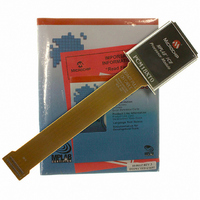PCM18XT0 Microchip Technology, PCM18XT0 Datasheet - Page 150

PCM18XT0
Manufacturer Part Number
PCM18XT0
Description
MODULE PROC PIC18F4685
Manufacturer
Microchip Technology
Datasheet
1.PCM18XT0.pdf
(484 pages)
Specifications of PCM18XT0
Accessory Type
Processor Module
Product
Microcontroller Modules
Core Processor
PIC18F4685
Lead Free Status / RoHS Status
Not applicable / Not applicable
For Use With/related Products
ICE2000
For Use With
ICE2000 - EMULATOR MPLAB-ICE 2000 POD
Lead Free Status / RoHS Status
Lead free / RoHS Compliant, Not applicable / Not applicable
- Current page: 150 of 484
- Download datasheet (9Mb)
PIC18F2682/2685/4682/4685
11.1
Timer0 can operate as either a timer or a counter; the
mode
(T0CON<5>). In Timer mode, the module increments
on every clock by default unless a different prescaler
value is selected (see Section 11.3 “Prescaler”). If
the TMR0 register is written to, the increment is
inhibited for the following two instruction cycles. The
user can work around this by writing an adjusted value
to the TMR0 register.
The Counter mode is selected by setting the T0CS bit
(= 1). In Counter mode, Timer0 increments either on
every rising or falling edge of pin RA4/T0CKI. The
incrementing edge is determined by the Timer0 Source
Edge Select bit, T0SE (T0CON<4>). Clearing this bit
selects the rising edge. Restrictions on the external
clock input are discussed below.
An external clock source can be used to drive Timer0;
however, it must meet certain requirements to ensure
that the external clock can be synchronized with the
FIGURE 11-1:
FIGURE 11-2:
DS39761C-page 150
Note: Upon Reset, Timer0 is enabled in 8-bit mode with clock input from T0CKI max. prescale.
T0CKI pin
Note: Upon Reset, Timer0 is enabled in 8-bit mode with clock input from T0CKI max. prescale.
is
T0CKI pin
Timer0 Operation
selected
T0SE
T0CS
T0PS2:T0PS0
PSA
F
OSC
T0SE
T0CS
T0PS2:T0PS0
PSA
F
/4
OSC
TIMER0 BLOCK DIAGRAM (8-BIT MODE)
TIMER0 BLOCK DIAGRAM (16-BIT MODE)
by
/4
0
1
clearing
0
1
Programmable
Prescaler
the
Programmable
Prescaler
3
T0CS
3
0
1
bit
1
0
(2 T
Sync with
Internal
Clocks
CY
(2 T
Delay)
Sync with
Internal
Clocks
CY
internal phase clock (T
synchronization and the onset of incrementing the
timer/counter.
11.2
TMR0H is not the actual high byte of Timer0 in 16-bit
mode; it is actually a buffered version of the real high
byte of Timer0, which is not directly readable nor
writable (refer to Figure 11-2). TMR0H is updated with
the contents of the high byte of Timer0 during a read of
TMR0L. This provides the ability to read all 16 bits of
Timer0 without having to verify that the read of the high
and low byte were valid, due to a rollover between
successive reads of the high and low byte.
Similarly, a write to the high byte of Timer0 must also
take place through the TMR0H Buffer register. The high
byte is updated with the contents of TMR0H when a
write occurs to TMR0L. This allows all 16 bits of Timer0
to be updated at once.
Delay)
Timer0 Reads and Writes in
16-Bit Mode
TMR0L
8
8
TMR0L
8
8
OSC
High Byte
© 2009 Microchip Technology Inc.
TMR0H
TMR0
8
). There is a delay between
8
8
Set
TMR0IF
on Overflow
Internal Data Bus
Set
TMR0IF
on Overflow
Read TMR0L
Write TMR0L
Internal Data Bus
Related parts for PCM18XT0
Image
Part Number
Description
Manufacturer
Datasheet
Request
R

Part Number:
Description:
Manufacturer:
Microchip Technology Inc.
Datasheet:

Part Number:
Description:
Manufacturer:
Microchip Technology Inc.
Datasheet:

Part Number:
Description:
Manufacturer:
Microchip Technology Inc.
Datasheet:

Part Number:
Description:
Manufacturer:
Microchip Technology Inc.
Datasheet:

Part Number:
Description:
Manufacturer:
Microchip Technology Inc.
Datasheet:

Part Number:
Description:
Manufacturer:
Microchip Technology Inc.
Datasheet:

Part Number:
Description:
Manufacturer:
Microchip Technology Inc.
Datasheet:

Part Number:
Description:
Manufacturer:
Microchip Technology Inc.
Datasheet:










